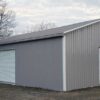Dissimilar Metals Overview
Metals that are dissimilar to one another, vary with regard to their differences in corrosion. Galvanic corrosion is a process that indicates a comparison of how metals corrode differently when in contact with an electrical connection. This system of ranking dissimilar metals is called the Galvanic Series which gives a good suggestion of which metals will be more likely to corrode first. Used in seawater it is possible to categorize metals and their rate of corrosion. This system gives builders a good representation of corrosive activity of metals as they are used in situations found in construction.
This Galvanic Series also indicates the preference a metal has toward other metals in specific environments. The metals will then be grouped by their patterns of behavior. When two metals are ranked closely, there is less of a chance that there will be a reaction between them. This ranking of metals in the same grouping indicates they are compatible. When two metals are further apart in their ranking, they are considered to be dissimilar and are more likely to exhibit galvanic corrosion when used together.
Galvanic Corrosion
According to the Multimedia Corrosion Guide, the definition of Galvanic Corrosion is “the effect resulting from contact between two different metals or alloys in a conducting corrosive environment”. The corrosive environment would include the presence of an electrolyte in order to form a galvanic couple. In the construction industry water is generally the electrolyte. Water may be seen in vapor or liquid form, such as humidity or rainwater. The galvanic couple that is formed will create an electron transfer and corrosion is the result. The more dissimilar the metals are the more corrosion will occur. For this reason, it is recommended that when building a structure more similar metals are used in order to slow down the effect of corrosion.
Rust on a corrugated sheet of iron is a common example of galvanic corrosion. This is likely to happen when the protective zinc coating is worn down and the steel core is exposed and eventually damaged. In comparison, using an ordinary tin can, there is no protective coating, such as with zinc so the opposite effect will take place. After the tin can’s coating is broken down, the steel beneath immediately shows indications of damage.
The more reactive metal is called the anode which during the galvanic corrosion process gives its electrons to the cathode which is the less reactive metal. This activity is the cause of corrosion. The position of metals in the Galvanic Series determines how soon it will begin corroding, however the cathode metal will not begin to corrode until the anode is entirely corroded. Using galvanized steel as an example, steel is dipped in or plated with molten zinc which results in steel that is coated with zinc. During the plating process hot-dipping the zinc disperses slightly into the steel. Because of this, if the zinc’s protective coating is scratched or pierced in some way, the steel and zinc will become a galvanic couple. In this example the zinc will act as the anode, giving out its electrons, and will corrode until there is almost nothing left. At that point is when the steel will start its corrosion.
Effect of Area
One factor that determines corrosion rate of a galvanic couple is the approximate area of the cathode. A steel clasp in an aluminum sheet functions as the anode because of fundamental behaviors of aluminum and steel in the Galvanic Series. However, due to the disproportion between the relatively small area of the clasp and the much larger area of the aluminum sheet, the clasp will give up electrons much faster. This event is called the area effect. If the opposite were the situation where an aluminum clasp breaks through a steel sheet, the steel will corrode but at a much slower rate as a result of the area of the steel.
Prevention of Galvanic Corrosion
Dissimilar metals corrosion, which is Galvanic Corrosion, will happen using any blend of metals. All metals will corrode at some point however selecting proper combinations of metals will offer the longest life possible for any two metals. It should be noted that three things are required in order to get a galvanic couple. These are:
- Electrical contact between dissimilar metals
- Corrosion rate will be determined by the extent of the dissimilarity
- Presence of an electrolyte
If any one of these three elements is missing, the possibility of forming a galvanic couple is greatly diminished. Using this knowledge, there are options available for preventing galvanic corrosion when building a structure. Considering that removing the moisture in the air is probably not an option, it would be an advantage to use similar metals according to the Galvanic Series, and create some sort of barrier that would prevent electrical contact between those similar metals. A thick and heavy paint might work perfectly as an electrical barrier, however selecting the best materials is recommended as the simplest solution to coupling. A builder might consider painting the cathode which will reduce the surface area and reduce the anode’s corrosion rate.
Metal Selection Practices
Roof Sheet: Galvanized / Galvalume
- Recommended Fastener(s):
- Galvanized steel
- 300 series S.S.
- 400 series S.S.
- Not Recommended:
- Aluminum
Roof Sheet: Aluminum
- Recommended Fastener:
- 300 series S.S.
- Not Recommended:
- Copper
- Galvanized steel
Roof Sheet: Copper
- Recommended Fastener(s):
- Copper
- 300 series S.S.
- Not Recommended:
- Galvanized steel
- Aluminum
Conclusion
Corrosive materials are an essential consideration for building construction, due to the fact that corrosion has an effect on the durability of the structure. Dissimilar metals vary in their speed of corrosion. Using the Galvanic Series, ranking of dissimilar metals indicate which metals will corrode faster in connection with their counterparts. As a general rule, trim and flashing should be made of a similar material that the sheets are made from. In a case of the roofing material being a different substance as the siding it is recommended to use a sealant tape, or thick heavy paint that will keep dissimilar metals separated at the point of contact.



